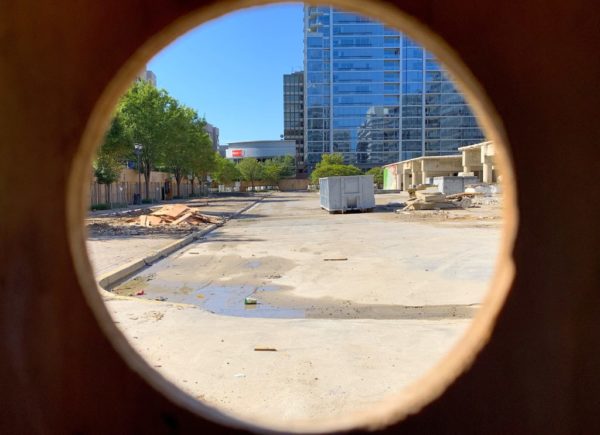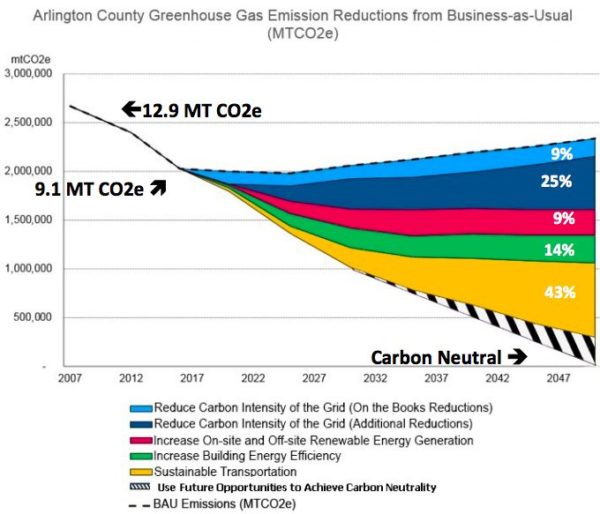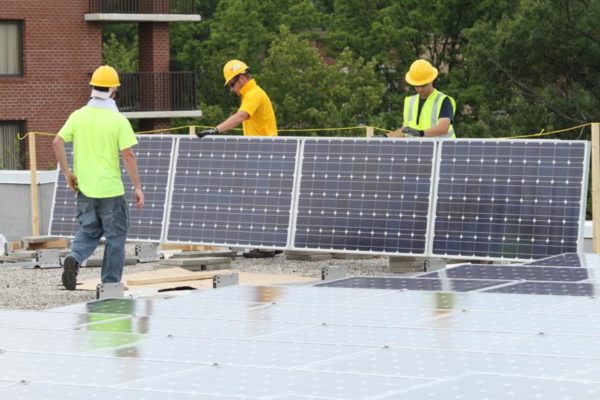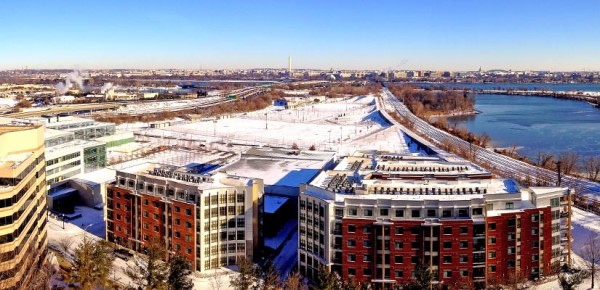
A proposed county contract aims to incentivize Arlington residents to resume buying as many solar panels as they once did.
The Arlington County Board on Saturday is set to consider whether to approve an agreement with Solar United Neighbors (SUN), which runs the Capital Area Solar Switch program, a co-op that provides financial incentives to people who buy solar panels from local vendors.
A county report argues that the county’s failure to enter into such an agreement last year caused a precipitous drop in solar installations.
“Until 2023, Arlington County was first, regionally and supra-regionally, in program performance,” the report says, noting that 401 residents registered for Solar Switch in 2022 and 26% had panels installed.
That all changed last year after SUN asked participating counties to enter into memorandums of understanding with the company, pledging to work with SUN to conduct public outreach about the program.
“Absent a full MOU, SUN advised that its ability to provide full outreach, marketing, and promotional services would be limited,” the report says. “In 2023, execution of an MOU with SUN did not occur.”
This had consequences for Arlington.
While program registrations surged in Maryland’s Montgomery and Frederick counties, which signed MOUs with the company, Arlington’s numbers slumped. Just 148 residents registered for the co-op last year — and of these, only 11, or 7%, went through with actually installing solar panels.
“Arlington County’s active participation with SUN’s annual solar co-op ‘Capital Area Solar Switch’ directly impacts the resulting number of rooftop PV solar that is installed on residential roofs in the County each year,” the report says. “In 2023, however, the marketing, outreach and promotional support to the County from SUN was [minimal]… While the County conducted promotions to educate residents and promote the solar co-op, SUN focused its time and resources where MOUs were in place and diverted their services and resources to those jurisdictions.”
Under the proposed memorandum of understanding, the county would agree to provide information about Solar Switch on its website, in blog posts and on its newsletter. The county would also agree to share social media posts, help with a “public launch” of the program and allow the company to use the county logo on some materials.
The contract notes that this is not a joint venture but rather, “an agreement between the Parties with the goal of furthering their respective missions.” The agreement would expire Dec. 31 unless the parties extended it.
Arlington’s Community Energy Plan seeks to have all of the county’s electricity come from renewable sources by 2035, with the goal of becoming fully carbon neutral by 2050.
That effort will require more significant buy-in from residents, advocates say, as all Arlington County operations have relied on renewable energy since early 2023. More than 80% of that power comes from offsets generated by the Arlington-Amazon solar panel farm in Pittsylvania County, which opened in 2022.
Photo via Arlington DES/Flickr
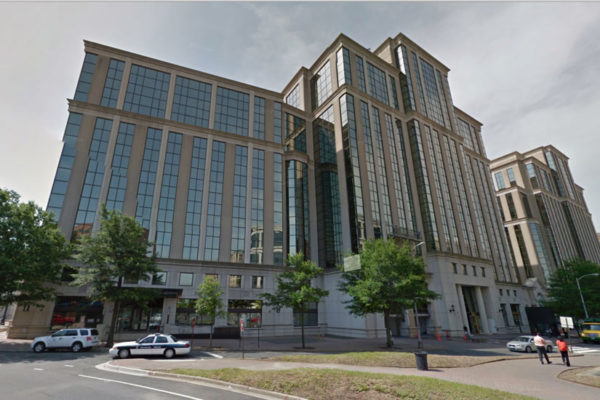
Arlington County operations now run entirely on renewable electricity — a full two years ahead of schedule.
As part of the Community Energy Plan adopted in 2019, Arlington County committed to transitioning 100% of county operations to renewable sources by 2025.
The county said in a press release sent out this morning (Thursday) that its buildings, streetlights and traffic signals, leased facilities and the Water Pollution Control Plant now run on electricity from sustainable sources.
This includes Dominion Energy Virginia’s Green Power program, solar panels and the Arlington-Amazon solar panel field in Pittsylvania County.
This last source up is in large part the reason Arlington met its goal two years early. The Arlington-Amazon solar panel farm in Pittsylvania County, which a Dominion Energy spokeswoman told ARLnow opened “late last year,” provides more than 80% of renewable electricity to Arlington facilities through offsets,
“We set an ambitious goal for net-zero County operations and facilities, as part of our overall Community Energy Plan for a fully carbon-neutral community, and we’ve met it – two years early,” County Board Member Katie Cristol said in a statement. “This exciting milestone is the result of cross-sector partnership, innovative approaches and Arlington’s commitment to doing our local part in addressing the global challenge of climate change.”
More from the press release:
Arlington County has committed to be carbon neutral by 2050 as part of its Community Energy Plan (CEP) by:
- Promoting buildings that are more energy efficient than is required by code.
- Enhancing Arlington’s approach to energy assurance and resiliency for critical services and harnessing the ability of nature to mitigate Arlington’s need for energy.
- Exploring alternative operational and financing mechanisms to support performance- and cost-effective renewable energy options.
- Maximizing the use of walking/biking, transit and use of shared vehicles, including micro-mobility devices, to promote a multimodal approach to transportation.
Arlington’s award-winning Community Energy Plan (CEP) is a long-term vision for transforming how the County generates, uses, and distributes energy. The CEP also aims to provide access to the benefits of clean energy sources for all residents regardless of economic situation.
Per the Community Energy Plan, the way Arlington intended to power all county operations with renewable electricity was through the purchase of power purchase agreements (PPAs). These can be either physical, through solar farms or more local solar panel installations, or virtual, via certificates.
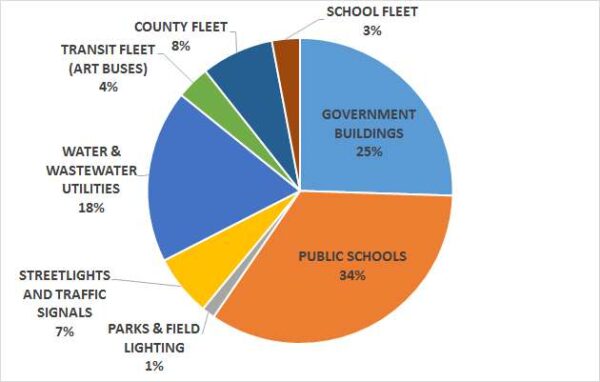
The next milestone in the CEP is powering 100% of Arlington’s electricity with renewable sources by 2035.
The ultimate goal is for the county to be completely carbon neutral by 2050, and the current efforts comprise just 11% of the greenhouse gas emissions reductions Arlington County says it needs to meet the ultimate goal of the Community Energy Plan.
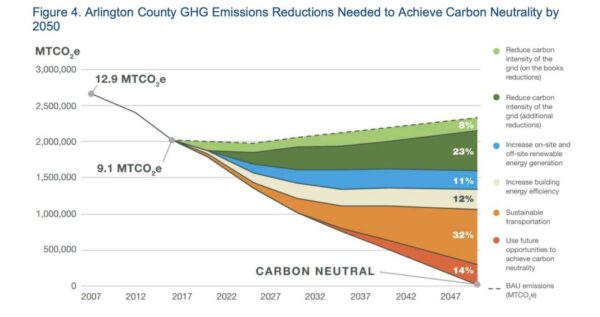
Arlington Public Schools — which contributed the most to Arlington County’s carbon footprint back in 2016 — continues to expand its solar capacity with new rooftop installations, says spokesman Frank Bellavia.
So far, three elementary schools — Alice W. Fleet, Discovery and Cardinal — are considered net-zero in terms of energy usage.
Solar power systems are being designed for Cardinal and Jefferson Middle School, and Bellavia says these should “host solar in the next year.”
“APS anticipates having over 3.4MW of solar capacity when these two schools’ solar arrays are operational,” he said.
Additionally, the school system is working on solar dashboards “so students and staff can use them as teaching and learning opportunities,” he said.
This school year, there are sustainability liaison positions at every school building, up from 10 participating schools when the program began in 2016.
“The Sustainability Liaison Program aims to support teachers at APS by providing a modest stipend in exchange for coordinating and designing sustainability activities that engage students and the APS community,” Bellavia said. “Given the success of the program in its first year, the program has expanded to 38 APS school facilities this year.”
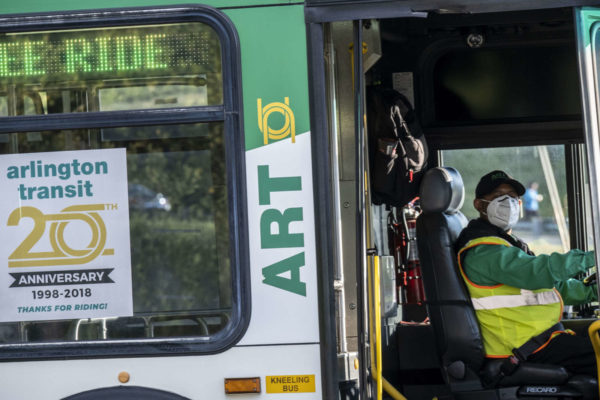
Metrorail riders could soon enjoy free transfers to Arlington Transit (ART) buses.
The Arlington County Board this Saturday is set to consider covering bus trips for SmarTrip card users who start their one-way trips on the Metro.
This move is part of a broader effort by the county, the region and Washington Metropolitan Area Transit Authority (WMATA) to recover ridership rates, which plummeted during the pandemic.
Ordinarily, transfer trips cost $1.50 rather than the full $2. Individual jurisdictions get to decide whether to offer a discount.
“The WMATA Fiscal Year (FY) 2023 budget includes an increase of the rail to bus transfer discount from $0.50 to $2.00,” notes a staff report to the County Board. “If adopted by Arlington County, the increase in the discount would result in rail-to-bus transfer fare on ART of $0.00 and would align with the WMATA transfer discount.”
Arlington County Transit Bureau Chief Lynn Rivers tells ARLnow that her department supports these free rides because they are a “win-win” for the county, where users need a blend of rail and buses to navigate its Metro corridors and suburbs.
“The more that people are on rail, the better it is for us,” she said. “We really endorse people to use public transit other than single occupancy vehicles. This is another way of doing that — by making another portion free.”
Ridership in Arlington plummeted from 49.5 million bus and rail trips in the 2019-20 fiscal year to 16.1 million in the 2021-22 fiscal year, which ended in June, per the report. This year, Arlington launched two pilot programs to increase ridership while offering reduced rates to low-income riders and students.
The free rides would cost the county $242,000, but Rivers said the tradeoff is that the program could generate more paying Metro customers.
The free transfers, if approved, would go into effect on Oct. 1.
The transfer discount is not the only opportunity for free rides on ART buses this fall. Arlington’s transit service has started testing out zero-emission buses (ZEBs) from several manufacturers as part of a pilot program, and is offering free fares to those who happen to board.
The battery-powered buses will tackle some of ART’s most challenging, hilly routes. The pilot program started Monday and is expected to continue into early 2023.
“The pilot will allow ART to collect data and assess vehicle performance during actual operation in the County,” according to a press release from the county. “Operators will drive ZEBs to test battery performance, range and response to Arlington’s geographic features including steep hills.”
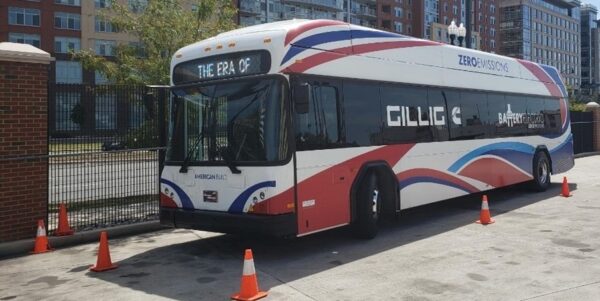
In-service test buses will have signs indicating the route and the free fare. Passengers are able to provide online feedback on their ridership experience on these battery-powered buses.
The schedule for this month’s test rides is as follows:

On Friday, the GILLIG battery electric bus will be parked on the 2100 block of 15th Street N. from 1-3 p.m. so people can see it, ask questions and learn more about the pilot program.
Arlington will repeat these pilot rides with two to three additional manufacturers this fall and winter.
Transitioning to zero-emission buses would help the county meet its goal of achieving carbon neutrality by 2050, the press release says. Arlington is also working to use renewable electricity for all of its government operations by 2025.
This regularly-scheduled sponsored column is written by the Arlington Initiative to Rethink Energy team (AIRE). This county program helps you make smart energy decisions that save you money and leaves a lighter footprint on the environment.
The Arlington County Board adopted sweeping updates to the Community Energy Plan setting ambitious targets for transforming the County’s energy sector. CARBON NEUTRAL BY 2050.
Many residents and stakeholders gave input and supported the recently updated Community Energy Plan. We don’t say it enough but we really mean it — THANK YOU! Thank you for your input and engagement.
Please join us for a happy hour to celebrate this and other recent actions, meet neighbors, and learn how you can take action.
Community Celebration and Kickoff to Carbon Neutral 2050
March 25, 5-7 p.m.
New District Brewing Company
2709 S. Oakland Street, Arlington, VA 22206
Space is limited, please click below to RSVP: https://www.eventbrite.com/e/community-celebration-kickoff-to-carbon-neutral-2050-tickets-96155476619?aff=ARLnow222
After months of debate and discussion, the Arlington County Board has unanimously approved a plan to reach carbon neutrality in Arlington by 2050.
The plan, approved at the Saturday (Sept. 21) County Board meeting, has environmental goals across six categories, from new building regulations to transportation goals and standards. More from a county press release:
The plan incorporates goals for buildings; resilience; renewable energy; transportation, County government actions, and education and human behavior. It envisions a carbon neutral Arlington by 2050 that will be more resilient, where all electricity will come from renewable sources, where more residents will drive electric vehicles and more will use transit, and where homes and buildings will be more energy-efficient.
The plan has been criticized as both too aspirational and not ambitious enough. While there was near-universal support for the idea behind the plan among speakers at the meeting, various members of the public and commission representatives expressed concerns about its implementation.
“We need to ensure sensitivity to individual circumstances isn’t lost in said implementation,” said Scott Pedowitz, government affairs manager for the Arlington Chamber of Commerce. “Businesses and residents should have the flexibility to meet the targets in a matter that makes practical and economic sense for their particular circumstance.”
Most of those who spoke represented various social and environmental groups and expressed support for tighter local environmental regulations. Several dozen gathered at a Sierra Club-organized rally outside of the County government headquarters at 2100 Clarendon Blvd to support the new plan and its clean energy goals
“We are excited about the clean energy bill coming from Arlington,” Karen Nightengale, president of the Arlington branch of the NAACP, told ARLnow. “The community needs it. It is really impacting multiple communities, especially brown and black communities living in low lying areas. We are excited about Arlington taking this step to go forward.”
Others testifying in the public hearing said they hoped for even earlier deadlines and stricter environmental measures.
“To really aim for a cleaner County, we need an earlier deadline for this plan,” said Jason Spitzak.
Elenor Hodges, executive director of EcoAction Arlington, said the recent protests in D.C. and activist Greta Thunberg’s testimony at the House of Foreign Affairs and Climate Crisis Committee were inspiring.
“We saw Greta Thunberg sail across the Atlantic and yesterday, thousands marched across the world in a climate strike,” Hodges said. “I hope we can take on [this] ambitious plan.”
Hodges said she’d like to see all new construction meet zero-carbon emissions standards and for Arlington’s tree canopy to be preserved or expanded.
In a three-page letter to the County Board, William Ross, chair of the Park and Recreation Commission, said he was disappointed in the final product. Ross argued the plan doesn’t do enough to promote or explore new green space options in Arlington.
“For all of the technical intensity of the plan, it misses some critical opportunities to improve our carbon footprint and mitigate the negative aspects of energy consumption because the plan fails to adequately address aspects of energy efficiency and environmental protection that are not wholly dependent on technology-based solutions,” Ross said.
After the plan’s approval, the Arlington County website says staff will now get to work on an implementation framework to be brought back to the County Board next June.
Jay Westcott contributed to this story
This regularly-scheduled sponsored column is written by the Arlington Initiative to Rethink Energy team (AIRE). This county program helps you make smart energy decisions that save you money and leaves a lighter footprint on the environment.
Climate change is serious. Businesses, residents and governments must act.
Today, the Arlington County Board has adopted sweeping updates to the Community Energy Plan setting ambitious targets for transforming the County’s energy sector.
Some highlights of Arlington’s Community Energy Plan include:
- Sets goal of a carbon neutral Arlington by 2050
- Government operations to achieve 100% renewable electricity by 2025
- Community to achieve 100% renewable electricity by 2035
- Considering energy equity during implementation
“This plan is bold, because nothing less than a bold response from every community across this nation and across the globe is essential to address the dire threat to our planet posed by climate change,” Arlington County Board Chair Christian Dorsey said.
“Arlington’s updated Community Energy Plan is based on the latest climate science and views energy decisions through the lenses of energy security, economic competitiveness, environmental commitment and equity. It will maintain Arlington County’s position as a leader in America on climate change mitigation and adaptation.”
The plan incorporates goals for buildings; resilience; renewable energy; transportation, County government actions, and education and human behavior. It envisions an Arlington that by 2050 will be more resilient, where all electricity will come from renewable sources, where more residents will drive electric vehicles and more will use transit, and where homes and buildings will be more energy-efficient.
Just this week similar announcements were made by Governor Northam to achieve 100% carbon-free electricity by 2050 for all of Virginia as well as an announcement by Amazon to fight climate change by achieving carbon neutrality by 2040.
We are proud of the work we’ve done to date to save money and energy. We are equally energized about the work ahead to reach carbon neutrality in Arlington by 2050.
Some simple actions you can take today to act and stay connected:
- Renovate or build with our Green Home Choice Program
- Install solar or an electric vehicle charger at a discount with our Co-op program
- Check out a thermal camera or LED box of bulbs at the Arlington County Library
- Join our email newsletter to stay current on events and programs
- Email [email protected] with the email subject of “Newsletter”
Please join us as we move forward. Every action makes a difference.
Together we can create a carbon-neutral Arlington by 2050.
Woman Arrested for Burning Flag Near W-L High — “A woman was arrested for burning an American flag on an overpass over I-66 in Arlington, police say. Kayla Caniff, 22, was charged with property destruction after police say she burned a flag attached to a chain link fence on the N. Stafford Street overpass, north of the Ballston area, at about 11:55 p.m. Thursday.” [NBC Washington]
County Website Goes Down — The Arlington County website was down for an extended period of time over Labor Day weekend. [Twitter]
Lucky Dog Takes in Pups from Hurricane’s Path — “While Hurricane Dorian battered the Bahamas — thousands of miles away in Arlington, Lucky Dog Animal Rescue plotted a rescue mission… The Carolinas are projected to be in the storm’s path and Lucky Dog Animal Rescue is partnered with a shelter in South Carolina. So the organization’s volunteers met an animal control officer part of the way there to take 19 of the shelter’s dogs.” [WJLA]
APS to Review Westover Tree Plan — “Facing community unrest in Westover, Arlington Public Schools plans to take another look at the potential of saving more trees during construction of a new elementary school on North McKinley Road near Washington Boulevard. Following an Aug. 29 meeting with residents, the school system has directed that ‘before the trees are removed, we have the contractor stake out the site and renumber the trees.'” [InsideNova]
Energy Plan Concerns: Feds and Trees — Arlington County’s impending update to its Community Energy Plan, which sets a net zero carbon emissions goal, is an important step in fighting climate change, some advocates say, though additional action is still needed on the state and federal level. Others, despite supporting the goal, are concerned that achieving it may come at the cost of the area’s tree canopy. [Washington Post, Arlington County]
Arlington’s Many Advocacy Orgs — “My viewing [of the Netflix documentary ‘The Family’] got me thinking of the many newsmaking organizations — of all political stripes — that have long populated our suburb so close to the action of the nation’s capital. Wilson Blvd. and Crystal City alone are home to enough colorful groups to generate a slew of political and public policy contretemps.” [Falls Church News-Press]
Reminder: Be Careful on the Roads Today — It’s the first day of school, kids will be walking to school and there are new traffic patterns around some schools. Arlington County Police are conducting “a high-visibility traffic enforcement campaign in and around school zones and bus stops” today. [ARLnow, Arlington County]
Photo courtesy David Johnson
Arlington County is working on plans to be “carbon neutral” by 2050.
The new goal comes is part of an ambitious update to the county’s current Community Energy Plan (CEP). It’s the result of community feedback that the earlier plan didn’t go far enough in addressing energy efficiency concerns, according to a staff report on the plan.
A pair of public hearings on the updates are expected to be scheduled for September at this weekend’s County Board meeting.
Carbon neutrality means reaching net zero metric tons of emissions each year. The idea behind the update is that, in 30 years, any carbon emissions would require some form of carbon offset in equivalent exchange.
The current plan, approved in 2013, targeted reaching three metric tons of CO2e (carbon dioxide equivalent) per capita by 2050. The updated goal relies on technology that is still science fiction as of 2019 and admittedly strains the boundaries of what the County is allowed to promise.
“Arlington’s community leaders point to today’s climate science reports as a need for people to take action and for a stronger, bolder CEP,” the report noted. “It is important to note that Virginia is a Dillon Rule state, that is, local governments have limited authority, and can pass ordinances only in areas where the General Assembly has granted clear authority. A more aspirational 2050 target of zero metric tons of CO2e per capita per year simultaneously pushes the limits local jurisdictions have in Dillon Rule states, and assumes numerous technological advancements and disruptions take place.”
Rich Dooley, Arlington’s community energy coordinator, said the Dillon Rule also means Arlington can’t require developers to build energy-efficient buildings above what is required by the state, they can only continue to offer incentives like bonus density for going above-and-beyond the state’s standards.
Even so, the report on the update points to several places where Arlington could be more energy efficient, from requiring greater levels of energy efficiency in new buildings to prioritizing public transit infrastructure over cars.
Buildings currently use approximately 60 percent of all energy in Arlington, according to the update. The 2013 plan charted a gradual reduction in energy use in residential buildings, ending with 40 percent less energy usage in 2040, compared to 2007 levels. The update shifts that goal to a 38 percent reduction by 2050, compared to 2016 levels.
Arlington County would also need to significantly scale up its solar energy production and purchasing. The updated plan says by 2025, solar energy should supply 100 percent of government operations and by 2050, solar energy should supply half of all electricity use in Arlington.
Dooley noted that the plan is meant to be a high-level look at the goals and policies of the project, and some of the next steps include working on updating the “dated” implementation framework.
The report notes that the specific shift to a carbon-neutral goal by 2050 was partially the result of prodding from the Arlington County Board.
“During its work session deliberations, the County Board members noted the importance of acting now to address climate change while keeping in mind the other important CEP goals,” the update said. “The work session concluded with County Board guidance to staff to show in the 2019 CEP that the community should aspire to become Carbon Neutral by 2050.”
Dooley said that staff initially presented the update as being able to realistically reduce emissions to one metric ton, but the community spoke up at meetings and said the County should commit to going to fully carbon neutral.
“The County Board heard that and said ‘we can go ahead and get it there,'” Dooley said.
If the technology to help Arlington reach its 2050 goals doesn’t materialize over the next few years, Dooley said there carbon offsets the County can purchase.
The update also includes other renewable energy objectives for the nearer term:
- Government operations will achieve 50% renewable electricity by 2022, and 100% renewable electricity by 2025.
- The community will achieve 100% renewable electricity by 2035.
But other concerns remain that the plan might not be authorized by the state government or that it might fail to address consumer emissions — emissions associated with the local consumption of products that aren’t created in Arlington.
At the County Board meeting on Saturday, July 13, the Board is expected to approve advertisement of a public Planning Commission hearing on Sept. 9 and a public hearing at the County Board meeting on Sept. 21.
Image via Arlington County
Arlington is looking for public input on a plan to use energy more efficiently.
Tonight (June 4) from 7-9 p.m. at the Central Library Auditorium (1015 N Quincy Street), county staff plan to host an open house during which the community can ask questions or offer feedback on an update to the county’s Community Energy Plan (CEP).
Goals for the project include:
- Increase the energy and operational efficiency of all buildings: By 2050, the plan aims to have total building energy usage in Arlington be 38 percent lower than in 2007. In the report, staff says both code-required reductions for buildings and incentives for voluntary efficiencies — a carrot and stick approach — will be required.
- Ensure Arlington’s energy resilience: The report notes — and anyone in Ballston two weeks ago can confirm — Arlington’s energy infrastructure is vulnerable to extreme weather and other factors. The report says Arlington will need to use new technologies to rely on more local sources of energy and potentially establish “microgrids” to make critical pieces of infrastructure like Joint Base Myer-Henderson Hall and the Virginia Hospital Center more independent from blackouts across the county.
- Increase locally generated energy supply: The plan aims to have Arlington County follow the example of Discovery Elementary, which won accolades for using all its energy generated on-site, and establish more solar energy collectors and other green energy sites across Arlington.
- Move more people with fewer greenhouse gas emissions: The goal here is fairly self-explanatory, but the general idea is to get more Arlingtonians using buses, bicycles, and other non-car means of transportation, while encouraging those who are required to use cars to shift toward hybrid and energy-efficient vehicles.
- Integrate energy goals into all county government activities: The report says Arlington should aim at having government facilities reduce CO2 emissions to 71 percent below their 2007 levels by 2040. The approach would involve a mix of smaller efficiencies in energy and water usage and larger shifts in making new government facilities more energy efficient from a design standpoint.
- Support residents and businesses that reduce energy usage: The final goal of the report involves using county staff and resources to help encourage locals — from individuals to business owners — find ways to rethink energy usage in their own lives.
“We invite the community to drop in and spend as much time as needed to learn about the draft CEP update, CEP implementation details, and provide feedback on the proposed changes to the 2013 CEP,” Rich Dooley, Arlington’s community energy coordinator, said in an email.
Arlington County officials promoted the Community Energy Plan approved last year in an online video released this week.
The plan, adopted in June 2013 after 15 months of community meetings, was designed to improve energy use through 2050 and set a national standard, County Board Chair Jay Fisette says in the eight- minute clip.
“A community energy plan is the next chapter of Arlington’s sustainability story,” Fisette says.
Officials explain how the county has reduced energy use in public buildings, including in the Central Library, where upgrades to lighting and other technology have cut usage by 25 percent since 2007.
Businesses and homeowners need to do their part, as the private sector accounts for 96 percent of the county’s energy use, said Community Energy Coordinator Rich Dooley.
“We’re looking at potential financial incentive programs for commercial building owners to try to get them to do more energy efficiency and renewable energy projects,” Dooley says.
Bikeshare Supplier Files for Bankruptcy — Bixi, the Canadian company that makes the bikes and equipment utilized by the Capital Bikeshare system, has filed for bankruptcy. Alta Bicycle Share, which runs the Capital Bikeshare system says it’s focused on making sure the system continues to operate “without interruption.” [Washington Business Journal, Capital Bikeshare]
Hope to Enter Congressional Race — Del. Patrick Hope (D-47) is planning to run for the retiring Rep. Jim Moran’s congressional seat. He’s expected to make the announcement today. [Washington Post]
Rader Clinic Recovering from Flood Damage — The Rader Clinic at Joint Base Myer-Henderson Hall is back up and running after a “water accident” that caused flood damage yesterday. [Facebook]
Arlington Energy Plan Wins Award — Arlington County’s Community Energy Plan has been recognized by the American Planning Association with a “2014 National Planning Achievement Award in Environmental Planning.” [Arlington County]
ARLnow Reaches 20K Twitter Followers — In the midst of snow coverage this week, ARLnow.com reached its 20,000th Twitter follower. The follower count now stands at 20,085. [Twitter]
Flickr pool photo by Joseph Gruber




